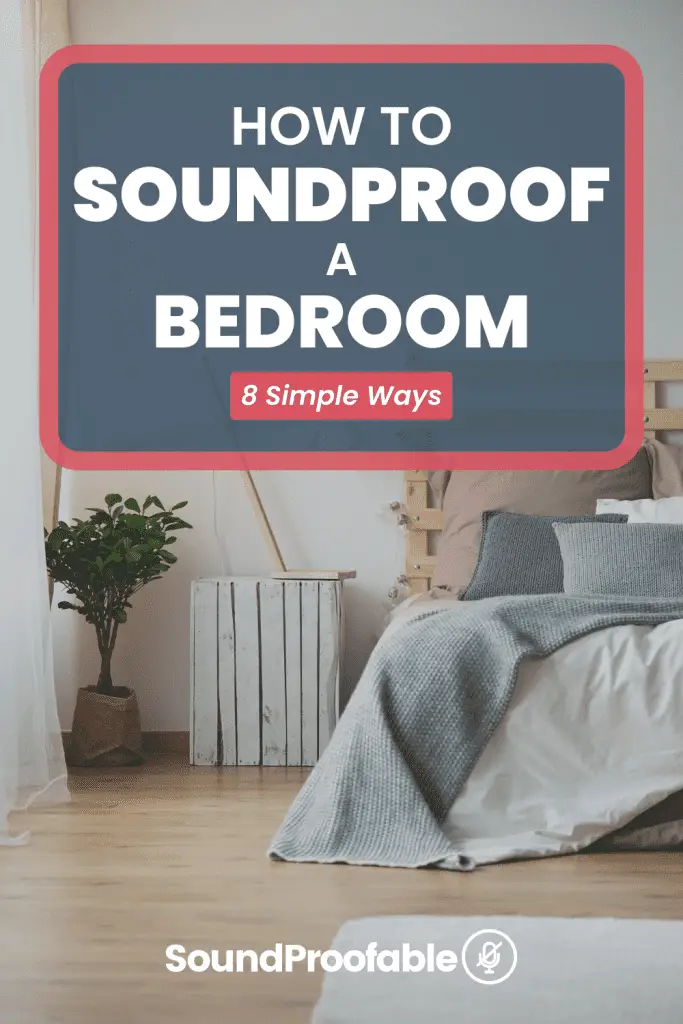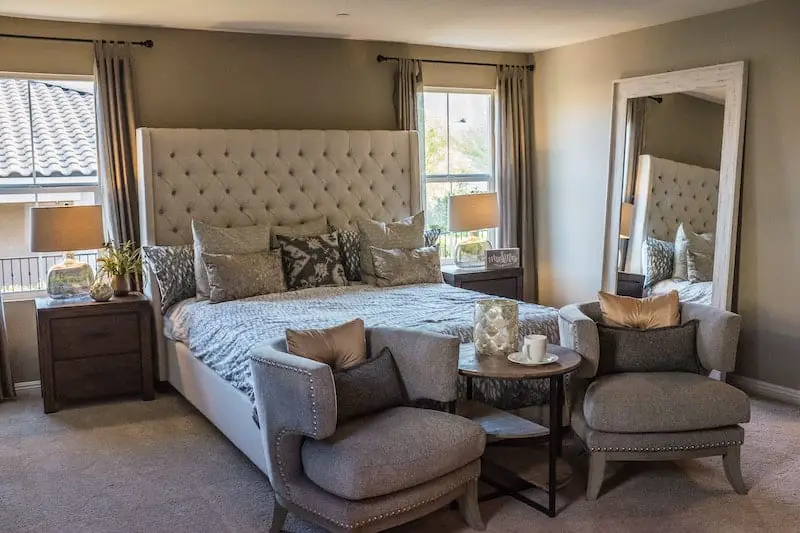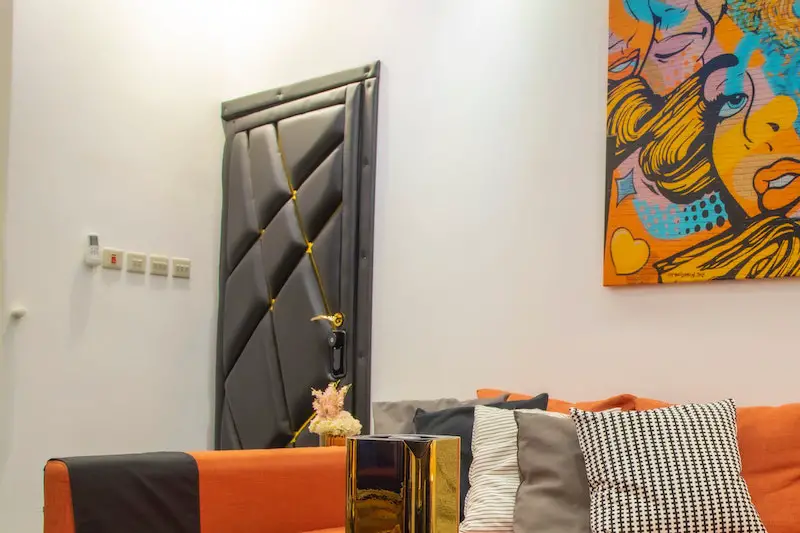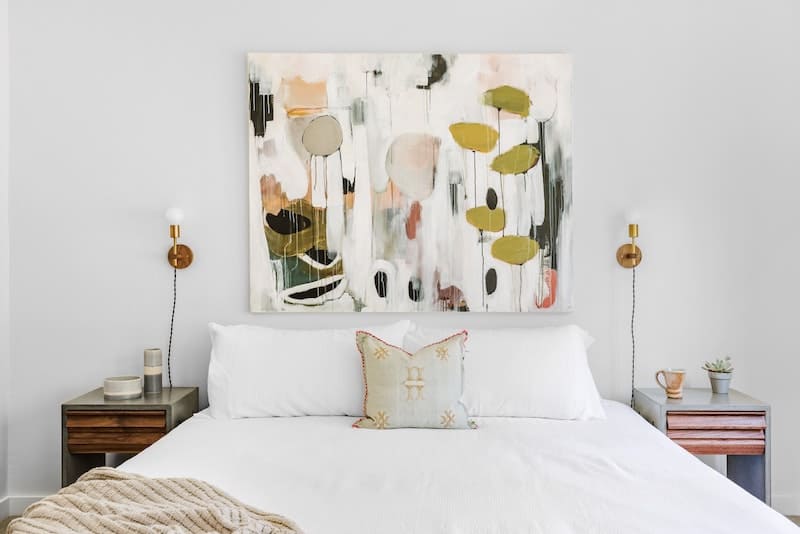While our bedroom is supposed to be a place of rest and relaxation, sometimes there’s just too much going on outside. Police sirens every night at 3 am? Check. Loud roommates coming home from a late-night out? Check. Sleepless night? Check.
Luckily, there are a few things you can do to solve the problem. If you’re wondering how to soundproof a bedroom, keep reading because we’re going to show you how.
Below, find some tips and tricks that you can use to inexpensively soundproof the different areas of your bedroom. Professional soundproofing costs a pretty penny, and there are way cheaper methods that can still make a difference no matter where the noise is coming from.

Soundproof Your Problem Areas First

Most bedrooms aren’t bombarded with noise from all directions. If yours is, then we feel for you. You’re probably going to need all of the following tips to get a good night’s sleep.
However, if you’re like most, you need to determine the specific areas of your room where the noise is coming from. Sometimes it sounds like it’s coming from everywhere, but that’s just because the soundwaves are bouncing around your room.
Figure out where sounds are loudest and plan to address those areas of the room first before moving on to others. For example, if your doorway is where the most noise comes from, you probably shouldn’t soundproof your walls first. You may even realize that you don’t need to soundproof the whole room after you’ve finished with one section.
Tips for Soundproofing Your Bedroom
Without further ado, here is our advice for how to soundproof a bedroom.
1. Hang Blankets on the Walls
Decorative blankets and heavy tapestries are economical alternatives to hanging potentially expensive art pieces. You can often find blankets and tapestries at thrift shops, flea markets, and online quite easily and for relatively low prices.
Again, heavier blankets are much better ideas than lighter ones when it comes to soundproofing. While a large blanket might intrude on the space a bit, you’ll realize how much better your noise problem is after just one night.
Large tapestries are excellent options because they’re soft and heavy, absorbing more sound than hard and sharp surfaces like a picture frame or shelving. They also come with cool designs that can enhance the space.
Make sure your blanket or tapestry is directly covering as much space on the wall as possible, and you should hear the results in no time.
2. Fill the Room With Furniture

If your room is lacking in the furniture department, your room might sound like an echo chamber. That’s because furniture like sofas, chairs, and bookcases all absorb and repel sound waves. The more you fill your bedroom with furniture, the less you’ll notice intrusive sounds.
You want to position your furniture in a way that covers the most floor and wall space possible. Move heavier furniture to the noisiest walls, while lighter furniture should be in areas where there isn’t much noise.
If you don’t have much space to work with, try moving some of your furniture out of the room and rearranging the rest. It will give you some wiggle room to figure out what the best orientation for your furniture might be.
Also, things like elevating your bed and putting some storage furniture underneath are cost-effective and easy fixes for soundproofing. Raising the bed covers more of the wall and installing under-bed storage reduces any sound that might come from below.
3. Install Shelving

Shelving is another excellent way to fill up more space on the wall and increase your room’s soundproofing. `You can use shelves to store decorations or things you need, meaning even better soundproofing. Although only a small difference, filling up your shelves with stuff means less sound can travel through that area of the room.
Multi-level shelving is a perfect soundproofing solution. They make a room look homier and also add a bunch of utility to the space. If you have the option, choose multilevel over a single shelf and make sure the material is as dense as possible. Also, wood is better for soundproofing than metal.
Install two or three heavy shelves on the wall and put up any books, pictures, candles, or any other decoration you can think of. If you have the option, it’s better to pick larger, heavier objects for your shelves than small and light ones.
4. Soundproof Your Door

Your door is probably another noisy area in your bedroom. If you don’t live alone, there’s probably someone walking by, chatting on the phone, or watching TV right outside your door. Doors are thinner than walls, and the gaps at the bottom and between the door frame let sound right into the space.
Soundproofing your door is a lot like soundproofing your walls. Covering it with a heavy tapestry or decorative blanket is sure to make a big difference in how much you hear coming through. Hanging a heavy framed picture will also help deaden sound waves, but not as much as covering the whole door might.
However, covering your door doesn’t address the number one noise problem in your room: the gap under the door. To fix this tricky space, consider buying a door gap cushion to seal the open space.
- SUPERIOR HOME PROTECTION: The under door draft blocker by DECOREALM protects any room...
- THE ORIGINAL FASHIONABLE DOOR DRAFT STOPPER: Don't be fooled by cheaper copies....
- DESIGNED AND CRAFTED TO LAST: Our under door blocker is designed for durability and...
It doesn’t get in the way of opening the door, and it absorbs almost all sound that reverberates under the frame.
If you don’t want to buy a door gap cushion, a towel or sweatshirt might work fine. Just throw it down to cover the gap when it gets noisy outside, and it should slightly reduce how much sound you hear. An oversized t-shirt might work too, but not as well as a thicker piece of clothing.
5. Lay Down a Rug or Install Carpeting

If you’ve got wood floors, the chances are that you can hear everything below you. While wood looks nice, it’s not great when it comes to keeping your room as quiet as possible. Instead, softer materials like carpeting or a shag rug might be much better for soundproofing your bedroom.
Installing carpeting is one of the best ways to soundproof a room. The carpet’s material absorbs sound waves and helps reduce vibrations from coming through the floor. When your downstairs neighbor is having a party, a carpet is probably your best line of defense against a sleepless night.
However, you might have already guessed that installing carpeting is expensive, even if you have a small room. It can be way too much to think about for larger rooms if you’re on a budget.
Buying a rug is an excellent budget alternative to carpeting. You can usually find a nice, heavy rug for fairly cheap, at least much cheaper than carpeting. Only go for thick and soft ones if you only care about soundproofing. Try to cover the area where the most noise comes from, but the center of the room works as well.
6. Decorate the Ceiling
If you live in an apartment, you might have upstairs neighbors banging around all day. Not only are the sounds disturbing, but you may actually be able to feel the vibrations through the walls.
We know the ceiling probably isn’t the first spot you thought to decorate when you moved in. However, soundproofing your ceiling with tapestries, blankets, or Mass Loaded Vinyl (MLV) is one of the best things you can do to reduce the noise levels in your room.
You might think that you don’t need to soundproof your ceiling if you don’t have any upstairs neighbors. However, if you’re still experiencing noise from another area of the room, it could actually be your ceiling that is to blame.
Sound waves bounce off the walls of your bedroom. Even if your walls are covered, a bare ceiling can reflect sounds back down at you that are otherwise muffled by your decorations. Soundproofing your ceiling means sounds have one less place to travel when they enter your bedroom.
While you may be intimidated by the prospect of hanging things on your ceiling, the process is more straightforward than you might think. Hollow wall anchors, hooks, removable adhesives, and double-sided tape all work just fine. Grab a ladder and enlist the help of a friend, and you’ll cover your ceiling in no time.
7. Put Up Some Art

If your walls are barren with little to no decoration, you may have found the cause of your noise problems. Hanging up some art is a great way to repel soundwaves from outside and liven up the space simultaneously.
While all art is nice to look at (well, maybe not ALL art), not everything you want to put up is good for soundproofing. For example, thin posters won’t block any noise from entering your bedroom. However, a framed poster in a durable and heavy frame might do the trick.
In general, the heavier the object, the better it is at deadening sound waves. Aim for thick canvases, large frames, or other art pieces that cover a large area. You can also fill the wall space with smaller pieces, but be aware that some sound waves will still travel through the gaps between each one.
8. Use a White Noise Machine
It might seem strange to fight noise with noise, but isn’t the saying fight fire with fire? A white noise machine can be the perfect solution for your bedroom’s noise issues. While it doesn’t prevent sound from entering your living space, it can help block the sound waves from reaching your ears.
White noise machines emit ambient soundwaves in whichever direction you face them. Turning it towards a noisy area of your room will help dampen and mask unwanted sounds.
Plus, your brain filters out white noise after hearing it for a while. When the white noise machine covers up the rest of the noise in your room, your brain then tunes out the white noise. Essentially, once you get used to the device, it’s like there’s no noise in your bedroom at all.
However, white noise machines can be pretty expensive, especially higher-quality ones. We recommend trying some of the cheaper methods listed above before resorting to a white noise machine.
Summing up Soundproofing Your Bedroom
As you can see, soundproofing your bedroom is a pretty easy process and doesn’t requisre too much disruption.
Depending on how loud the noise in your room is right now and how much money you want to spend, you may have to pick and choose between the methods listed.
We help these tips will help keep the noise out by reducing how much sound gets into your bedroom in the first place and you can finally have a good night’s sleep.

